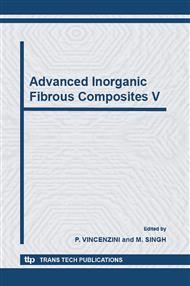p.107
p.115
p.124
p.130
p.141
p.147
p.153
p.163
p.174
Advanced Composite Materials for Current and Future Propulsion and Industrial Applications
Abstract:
Various technology programmes in Europe are concerned with preparing for future propulsion technologies to reduce the costs and increase the life time of components for liquid rocket engine components. One of the key roles to fulfil the future requirements and for realizing reusable and robust engine components is the use of modern and innovative materials. One of the key technologies which concern various engine manufacturers worldwide is the development of fibrereinforced ceramics – CMC's (Ceramic Matrix Composites). The advantages for the developers are obvious – the low specific weight, the high specific strength over a large temperature range, and their good damage tolerance compared to monolithic ceramics make this material class extremely interesting as a construction material. Different kind of composite materials are available and produced by EADS ST, the standard material SICARBON® (C/SiC made by Liquid Polymer Infiltration) and the new developed and qualified composite materials SICTEX® (C/SiC made by Liquid Silicon Infiltration) and CARBOTEX® (C/C made by Rapid Chemical Vapour Infiltration). The composites are based on textile techniques like weaving, braiding, stiching and sewing to produce multiaxial preforms, the SICTEX® material is densificated by the cost effective Liquid Silicon Infiltration (LSI). Over the past years, EADS Space Transportation (formerly DASA) has, together with various partners, worked intensively on developing components for airbreathing and liquid rocket engines. Since this, various prototype developments and hot firing-tests with nozzle extensions for upper and core stage engines and combustion chambers of satellite engines were conducted. MBDA France and EADS-ST have been working on the development of fuel-cooled composite structures like combustion chambers and nozzle extensions for future propulsion applications.
Info:
Periodical:
Pages:
174-181
Citation:
Online since:
October 2006
Keywords:
Price:
Сopyright:
© 2006 Trans Tech Publications Ltd. All Rights Reserved
Share:
Citation:


